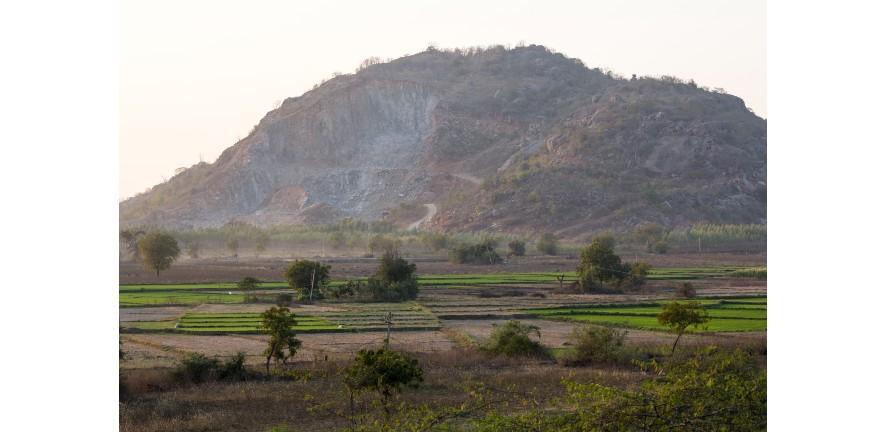
Submitted by K.L. Hlaba on Thu, 14/10/2021 - 16:26
During the Summer of 2021, I was fortunate enough to undertake a remote internship with Flagship Project 1 (FP1) START (Sustainable and Transformative Agrarian and Rural Trajectories) of the TIGR2ESS programme. For six weeks, I worked remotely to collate five detailed site profiles for each of the FP1 field sites, from the mountainous Bhaisiya Chhana block in Uttarakhand to the coastal Sirkazhi block in Tamil Nadu. Primarily, the site profiles were produced to accompany the extensive body of data and other research outputs produced by the FP1 team. Additionally, it is hoped that these profiles will help inform policy decisions and future research.
Map: START Field Sites.
1. Chakai Block, Bihar
2. Bhaisiya Chhana Block, Uttarakhand
3. Bathinda Block, Punjab
4. Atmakur Block, Telangana
5. Sirkazhi Block, Tamil Nadu
Before beginning my work for START, though being theoretically aware of the socio-economically and environmentally diverse nature of India’s states and districts, I struggled to clearly envisage how and in what ways this would practically manifest. It was not until I started profiling the field sites that the complex differences that exist between states, districts, blocks, panchayats, and villages became apparent to me. To give just one example, there is a huge amount of variation in the water sources used for agriculture at the state, block, and village levels. In some cases, these differences are reflective of the field site’s distinct physical environments. For instance, while in some of the sites profiled (e.g., Bhaisiya Chhana block, Uttarakhand) the agricultural sector can utilise groundwater, this is not possible in others due to the site’s location and environmental conditions. The most prominent example is that of Vanagiri village (Sirkazhi block, Tamil Nadu). Due to its proximity to the coast, Vanagiri’s groundwater supply is largely saline and unusable due to saltwater intrusion. As a result, the agricultural sector in Vanagiri is instead dependent on river water and canal irrigation. This is just one example that demonstrates how the differences present in the environmental conditions of each field site works to shape the various agricultural practices.
However, there were also striking similarities that spanned across multiple sites, despite their geographical dispersion. To return to the groundwater example, both primary and secondary data sources clearly indicated that groundwater levels across several sites had lowered significantly over the past decades. This was particularly true in Bathinda block, Sirkazhi block, and Atmakur block. Overall, in each case, this is attributable to the over-extraction of groundwater resources to meet the demands of different sectors. For example, while groundwater over-extraction was primarily attributable to paddy cultivators in Bathinda block, in Sirkazhi block it was instead the result of unsustainable shrimp cultivation practices. Therefore, while both sites experience the problem of groundwater depletion, it is for fundamentally different reasons embedded within distinct policy, socio-economic and environmental contexts. More broadly, I hope the inclusion of such fine details and differences between sites within the profiles helps to equip future researchers with local knowledge that helps to prevent over-generalisations through a focus on larger aggregated regions.
However, balancing the need for uniformity in the presentation of the site profiles with the at times conflicting desire to illustrate distinct features of each block, panchayat, or village was challenging. Finding a format that was structured enough to allow for comparison between sites, while also allowing for the specificity of the sites to shine through, was one of the main challenges I faced when compiling this document. This was further complicated by the presence of differences in the amount, type, and level of granularity of data available for each site. However, with the cooperation of a large team of contributors from a range of different organisations like MSSRF, ICRISAT, and PRADAN, the profiles came together cohesively. This is also thanks to the decision to include small case studies to highlight key features of each field site (e.g., the impact of the 2004 Tsunami on Sirkazhi or the Katakshapur tank project in Atmakur). I hope that this has helped bring the profiles to life and spotlighted the site’s diversity, while still providing the reader with consistently formatted and rich site descriptions.
One of the main takeaways from my internship with START is a renewed appreciation for the rural and the local as a scale of geographical enquiry. Over the past two years, I have studied at geography the University of Cambridge, which has given me countless opportunities to expand my ideas of what geography is and does as a discipline. However, there is often a privileging of the national and the global scale. Moreover, in instances where I have had the opportunity to engage with the local, this has often meant the urban. Therefore, though I have found my undergraduate course immensely fulfilling, I was grateful for the opportunity to engage with the rural and the local in such detail. In particular, the ability to read primary data outputs from stakeholder interviews, focus groups, and community mapping sessions meant I felt engaged with the specific villages and panchayats, despite being thousands of miles away. Access to some stunning pictures from the various sites only amplified this sense of engagement. For instance, the pictures of the hills in the otherwise flat landscape of Katakshapur village (Atmakur block) (main image) brought the details of the arduous work of stone-cutting by men of marginalised households in the site to life in a way that I had not anticipated. While, of course, this is in no way similar to experiencing the field sites first-hand, it has been a privilege to work so closely with these sites through the contributions of all the researchers involved.
Finally, I would like to thank Dr. Shreya Sinha for her support and supervision, and Flagship Project 1 lead Professor Bhaskar Vira. I would also like to thank the entire START FP1 team for their contributions, guidance, and support throughout.
Written by Matilda Wring.
Please find the site profiles here.
Main image by Toby Smith.

